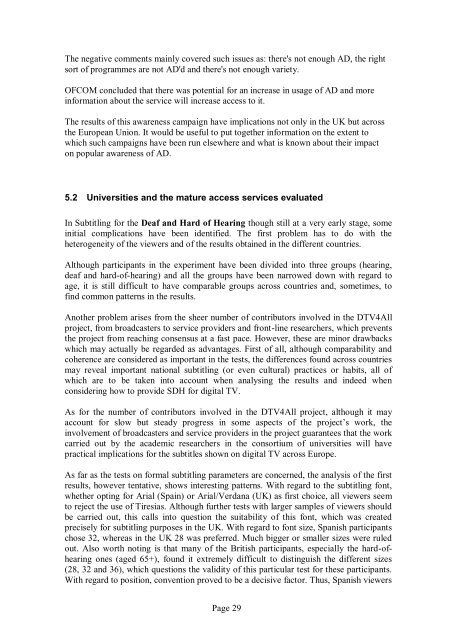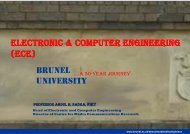D2.3 Interim Report on Pilot Services - the School of Engineering ...
D2.3 Interim Report on Pilot Services - the School of Engineering ...
D2.3 Interim Report on Pilot Services - the School of Engineering ...
Create successful ePaper yourself
Turn your PDF publications into a flip-book with our unique Google optimized e-Paper software.
The negative comments mainly covered such issues as: <strong>the</strong>re's not enough AD, <strong>the</strong> rightsort <strong>of</strong> programmes are not AD'd and <strong>the</strong>re's not enough variety.OFCOM c<strong>on</strong>cluded that <strong>the</strong>re was potential for an increase in usage <strong>of</strong> AD and moreinformati<strong>on</strong> about <strong>the</strong> service will increase access to it.The results <strong>of</strong> this awareness campaign have implicati<strong>on</strong>s not <strong>on</strong>ly in <strong>the</strong> UK but across<strong>the</strong> European Uni<strong>on</strong>. It would be useful to put toge<strong>the</strong>r informati<strong>on</strong> <strong>on</strong> <strong>the</strong> extent towhich such campaigns have been run elsewhere and what is known about <strong>the</strong>ir impact<strong>on</strong> popular awareness <strong>of</strong> AD.5.2 Universities and <strong>the</strong> mature access services evaluatedIn Subtitling for <strong>the</strong> Deaf and Hard <strong>of</strong> Hearing though still at a very early stage, someinitial complicati<strong>on</strong>s have been identified. The first problem has to do with <strong>the</strong>heterogeneity <strong>of</strong> <strong>the</strong> viewers and <strong>of</strong> <strong>the</strong> results obtained in <strong>the</strong> different countries.Although participants in <strong>the</strong> experiment have been divided into three groups (hearing,deaf and hard-<strong>of</strong>-hearing) and all <strong>the</strong> groups have been narrowed down with regard toage, it is still difficult to have comparable groups across countries and, sometimes, t<strong>of</strong>ind comm<strong>on</strong> patterns in <strong>the</strong> results.Ano<strong>the</strong>r problem arises from <strong>the</strong> sheer number <strong>of</strong> c<strong>on</strong>tributors involved in <strong>the</strong> DTV4Allproject, from broadcasters to service providers and fr<strong>on</strong>t-line researchers, which prevents<strong>the</strong> project from reaching c<strong>on</strong>sensus at a fast pace. However, <strong>the</strong>se are minor drawbackswhich may actually be regarded as advantages. First <strong>of</strong> all, although comparability andcoherence are c<strong>on</strong>sidered as important in <strong>the</strong> tests, <strong>the</strong> differences found across countriesmay reveal important nati<strong>on</strong>al subtitling (or even cultural) practices or habits, all <strong>of</strong>which are to be taken into account when analysing <strong>the</strong> results and indeed whenc<strong>on</strong>sidering how to provide SDH for digital TV.As for <strong>the</strong> number <strong>of</strong> c<strong>on</strong>tributors involved in <strong>the</strong> DTV4All project, although it mayaccount for slow but steady progress in some aspects <strong>of</strong> <strong>the</strong> project’s work, <strong>the</strong>involvement <strong>of</strong> broadcasters and service providers in <strong>the</strong> project guarantees that <strong>the</strong> workcarried out by <strong>the</strong> academic researchers in <strong>the</strong> c<strong>on</strong>sortium <strong>of</strong> universities will havepractical implicati<strong>on</strong>s for <strong>the</strong> subtitles shown <strong>on</strong> digital TV across Europe.As far as <strong>the</strong> tests <strong>on</strong> formal subtitling parameters are c<strong>on</strong>cerned, <strong>the</strong> analysis <strong>of</strong> <strong>the</strong> firstresults, however tentative, shows interesting patterns. With regard to <strong>the</strong> subtitling f<strong>on</strong>t,whe<strong>the</strong>r opting for Arial (Spain) or Arial/Verdana (UK) as first choice, all viewers seemto reject <strong>the</strong> use <strong>of</strong> Tiresias. Although fur<strong>the</strong>r tests with larger samples <strong>of</strong> viewers shouldbe carried out, this calls into questi<strong>on</strong> <strong>the</strong> suitability <strong>of</strong> this f<strong>on</strong>t, which was createdprecisely for subtitling purposes in <strong>the</strong> UK. With regard to f<strong>on</strong>t size, Spanish participantschose 32, whereas in <strong>the</strong> UK 28 was preferred. Much bigger or smaller sizes were ruledout. Also worth noting is that many <strong>of</strong> <strong>the</strong> British participants, especially <strong>the</strong> hard-<strong>of</strong>hearing<strong>on</strong>es (aged 65+), found it extremely difficult to distinguish <strong>the</strong> different sizes(28, 32 and 36), which questi<strong>on</strong>s <strong>the</strong> validity <strong>of</strong> this particular test for <strong>the</strong>se participants.With regard to positi<strong>on</strong>, c<strong>on</strong>venti<strong>on</strong> proved to be a decisive factor. Thus, Spanish viewersPage 29
















